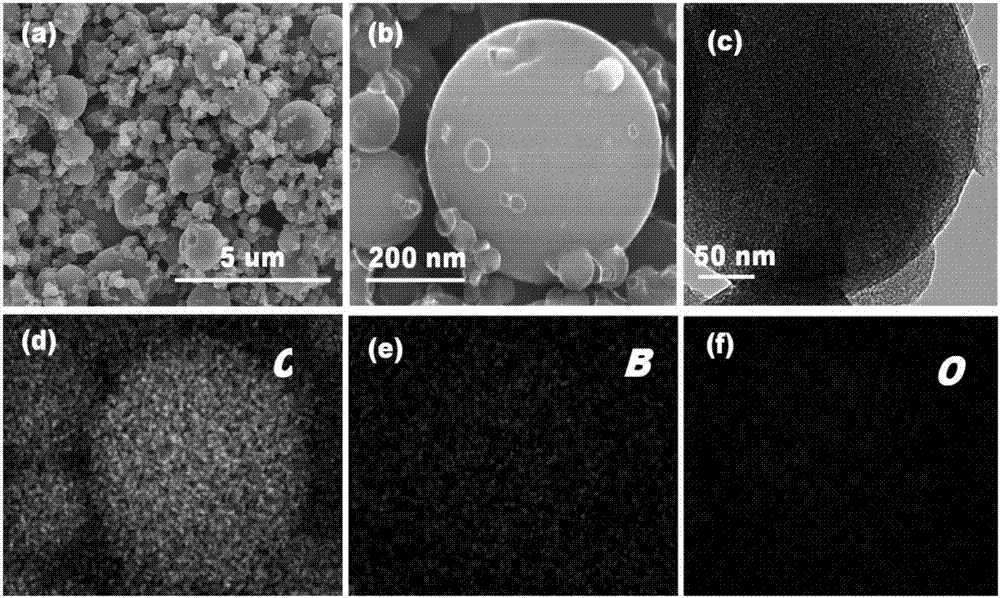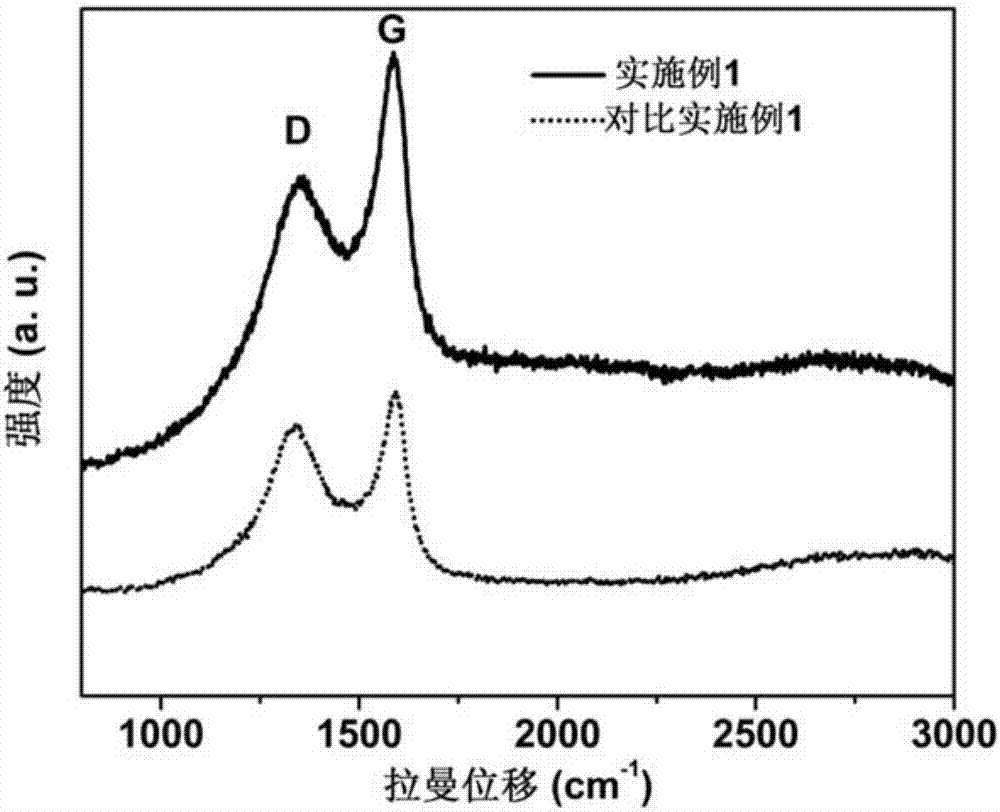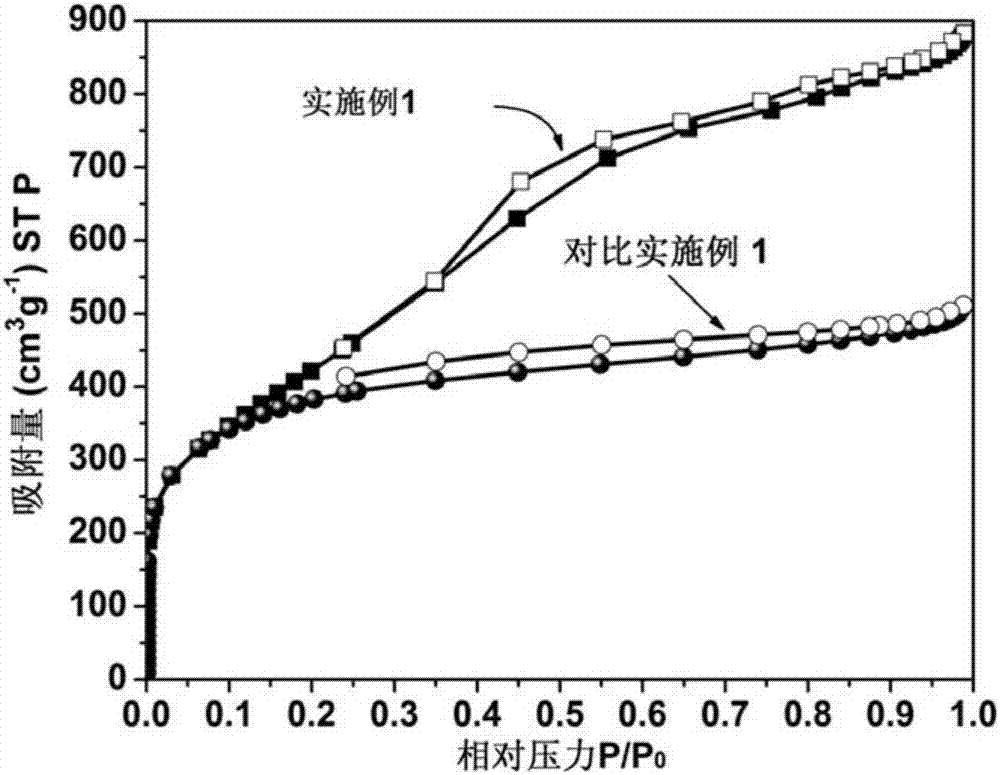Method for preparing boron-doped porous carbon spheres
A technology of boron doping and porous carbon, which is applied in the synthesis field of boron doped porous carbon spheres, can solve the problems of high cost, low boron doping amount, difficult large-scale production, etc., and achieve the effect of simple process
- Summary
- Abstract
- Description
- Claims
- Application Information
AI Technical Summary
Problems solved by technology
Method used
Image
Examples
Embodiment 1
[0045]The preparation method of boron-doped porous carbon spheres in this example is realized according to the following steps: Weigh 1.8g of glucose and 1.24g of boric acid dissolved in 15mL of deionized water and stir until completely dissolved, then add 4.2g of tetraethylorthosilicate ethyl ester, 2mL 0.1mol / L hydrochloric acid, 15mL ethanol and stirred for 1h to form a precursor solution, and then the precursor solution was carried by nitrogen into an aerosol-assisted spray drying device at a temperature of 450°C, and the nitrogen flow rate was controlled to be 500mL / min, and the obtained solid product Use a tube furnace to raise the temperature to 900°C at a rate of 8°C / min in nitrogen and keep it warm for 3 hours. The carbonized product obtained is washed with 10% hydrofluoric acid and deionized water for 3 times, and then dried at 80°C for 10 hours. , to obtain boron-doped porous carbon spheres in this embodiment.
Embodiment 2
[0049] Weigh 1.8g of sucrose and 1.8g of boric acid dissolved in 15mL of deionized water and stir until completely dissolved, then add 4.2g of tetraethylorthosilicate, 2mL of 0.1mol / L hydrochloric acid, 15mL of ethanol and stir for 1h to form a precursor solution. Then the precursor solution is carried by nitrogen into the aerosol-assisted spray drying device with a temperature of 450 °C, and the nitrogen flow rate is controlled to be 500 mL / min. The obtained solid product is heated in a tube furnace at a rate of 8 °C / min in nitrogen. Temperature was maintained at 900° C. for 3 hours, and the obtained carbonized product was centrifuged and washed three times with 10% hydrofluoric acid and deionized water, and then dried at 80° C. for 10 hours to obtain boron-doped porous carbon spheres in this example. XPS analysis showed that the boron content of the boron-doped porous carbon sphere was 4.5%.
Embodiment 3
[0051] Weigh 1.8g of soluble starch and 1.24g of boric acid dissolved in 15mL of deionized water and stir until completely dissolved, then add 4.2g of tetraethylorthosilicate ethyl ester, 2mL of 0.1mol / L hydrochloric acid, 15mL of ethanol and stir for 1h to form a precursor solution , and then the precursor solution is carried by nitrogen into the aerosol-assisted spray drying device with a temperature of 450°C, and the nitrogen flow rate is controlled to be 500mL / min. The obtained solid product is heated in a tube furnace at a rate of 8°C / min in nitrogen The temperature was raised to 900° C. and kept for 3 hours. The obtained carbonized product was centrifuged and washed three times with 10% hydrofluoric acid and deionized water, and then dried at 80° C. for 10 hours to obtain the boron-doped porous carbon spheres in this example. XPS analysis showed that the boron content of the boron-doped porous carbon sphere was 3.2%.
PUM
| Property | Measurement | Unit |
|---|---|---|
| size | aaaaa | aaaaa |
Abstract
Description
Claims
Application Information
 Login to View More
Login to View More - R&D
- Intellectual Property
- Life Sciences
- Materials
- Tech Scout
- Unparalleled Data Quality
- Higher Quality Content
- 60% Fewer Hallucinations
Browse by: Latest US Patents, China's latest patents, Technical Efficacy Thesaurus, Application Domain, Technology Topic, Popular Technical Reports.
© 2025 PatSnap. All rights reserved.Legal|Privacy policy|Modern Slavery Act Transparency Statement|Sitemap|About US| Contact US: help@patsnap.com



